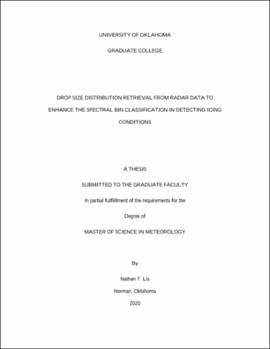| dc.contributor.advisor | Zhang, Guifu | |
| dc.contributor.author | Lis, Nathan | |
| dc.date.accessioned | 2020-07-20T19:53:04Z | |
| dc.date.available | 2020-07-20T19:53:04Z | |
| dc.date.issued | 2020-07-31 | |
| dc.identifier.uri | https://hdl.handle.net/11244/325286 | |
| dc.description.abstract | The emerging Federal Aviation Administration (FAA) restrictions on flight into and out of terminal airspaces (TASs) require discrimination between freezing rain, freezing drizzle, and other forms of winter precipitation to avoid in-flight icing. In this research, several methods for refining hydrometeor phase delineation within a Spectral Bin Classification (SBC) algorithm currently implemented within the Multi-Radar/Multi-Sensor (MRMS) system are analyzed. Sensitivity tests indicate that dynamic estimates of the drop size distribution (DSD) are needed to enhance precipitation classification, and reliable results can be obtained with a simple reflectivity-only based Marshall-Palmer type distribution. In addition, vertical super-sampling of the wetbulb temperature profile allows for a more accurate assessment of the liquid-water fraction within temperature regimes that fluctuate around zero Celsius, and refinements to precipitation discrimination rules have the potential to further improve detection for certain events.
These modifications are tested within the MRMS framework, and the resulting surface precipitation classification is verified. In comparison to the original version of the code, more realistic fine-scale detail of the hydrometeor phase distribution is obtained, as is a more refined analysis of the liquid-water fraction. Verification against both Automated Surface Observing System (ASOS) and Meteorological Phenomena Identification Near the Ground (mPING) observations shows improvement, with statistics indicating between a 5-10% increase in probability of detection for rain and rain-snow mix classifications, as well as improved detection of mixed phase precipitation, due to the modifications. Novel methods of visualizing hydrometeor phase across the DSD for each TAS show promise as decision support tools, and this updated SBC product will be implemented into an operational setting in the near future. | en_US |
| dc.language | en_US | en_US |
| dc.subject | Aircraft Icing | en_US |
| dc.subject | Drop Size Distribution | en_US |
| dc.subject | Hydrometeor Classification | en_US |
| dc.subject | Precipitation Microphysics | en_US |
| dc.title | Drop Size Distribution Retrieval from Radar Data to Enhance the Spectral Bin Classification in Detecting Icing Conditions | en_US |
| dc.contributor.committeeMember | Reeves, Heather | |
| dc.contributor.committeeMember | Gao, Jidong | |
| dc.contributor.committeeMember | Xu, Feng | |
| dc.date.manuscript | 2020-07-20 | |
| dc.thesis.degree | Master of Science in Meteorology | en_US |
| ou.group | College of Atmospheric and Geographic Sciences::School of Meteorology | en_US |
| shareok.orcid | https://orcid.org/0000-0002-4352-3747 | en_US |
